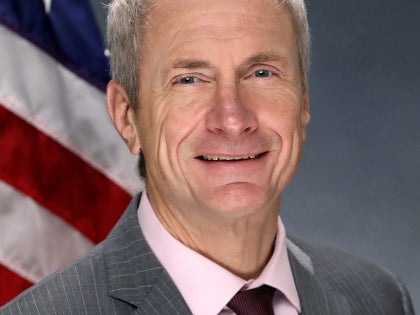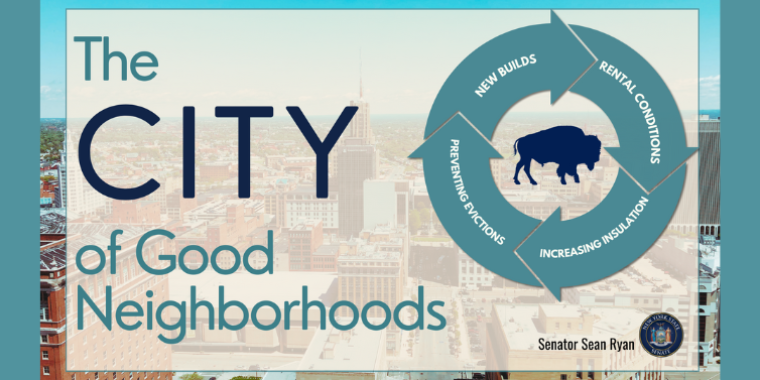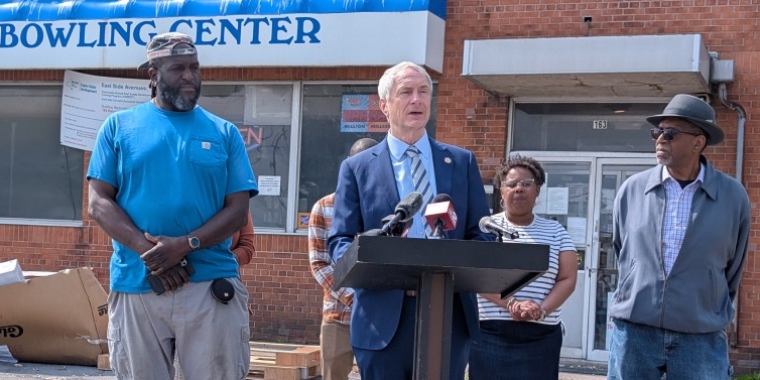
‘The City Of Good Neighborhoods’: Senator Sean Ryan Announces Comprehensive Housing Plan Focused On Meeting The Needs Of Buffalo And Upstate New York
January 25, 2024

BUFFALO – Today, January 25, 2024, New York State Senator Sean Ryan unveiled The City of Good Neighborhoods: A Housing Vision Built for Buffalo, a comprehensive, community-focused plan to address the shortage of high-quality, affordable housing in Buffalo. By increasing the number and improving the condition of affordable housing units in the city, the plan will address the various barriers to keeping people housed in Buffalo.
*Click here to watch Senator Ryan's full presentation. A PDF of the slideshow is available for download here.*
In an effort to make affordable housing more readily available to homebuyers and renters across Buffalo, the plan features four components that combine to address many of the underlying problems that have led to a lack of access to affordable housing in Buffalo and similar cities throughout New York. The plan includes proposals to incentivize infill housing, improve rental conditions, make old houses more energy efficient, and prevent evictions.
Senator Sean Ryan said, “If we want to make buying or renting a home attainable for all Western New Yorkers, there are two things that we need to recognize: First, that Buffalo’s housing challenges aren’t the same as New York City’s housing challenges – applying downstate solutions to upstate cities isn’t going to fix what’s broken here. Second, our housing access problems have been caused by decades of disinvestment, and solving them is going to require a multifaceted approach that includes investing in the city.”
Incentivizing Construction of Affordable Homes in Buffalo
Buffalo’s population is growing for the first time in 70 years, but there are too few new houses being built to meet the city’s needs. With housing demand far exceeding supply, entry-level homes have become unattainable for the average first-time home buyer. For those who are able to afford a house, inflated prices have led many to spend more money on homes that are often in need of repair or rehabilitation.
New York’s existing housing programs typically incentivize building large apartment buildings and utilize local tax abatements, two solutions based on New York City’s needs. However, Buffalo is primarily a city of one- and two-family homes, not large apartment complexes, and the issue in Buffalo is not a lack of land; there are 13,000 vacant residential lots in Buffalo, including approximately 7,500 city-owned lots.
Senator Ryan is proposing a program to include in this year’s state budget that would create 2,000 new starter homes in Buffalo over a five-year period. The program would be funded by the New York State Office of Homes and Community Renewal, and would provide subsidies to incentivize the construction of one- and two-family houses that could be sold to prospective homebuyers with low-to-moderate incomes, focusing on local residents who could afford a monthly mortgage payment but have been pushed out of the market by skyrocketing interest rates and inflated home prices. It would be a proof-of-concept pilot program that could later be extended and replicated in other cities across the state experiencing similar housing problems.
Senator Sean Ryan said, “Buffalo needs more housing stock to sustain its growth. The market isn’t producing the kind of housing we need, and it’s squeezing out first-time homebuyers and clogging up the local rental market. Incentivizing construction of new starter homes will soften the local housing market, help Buffalonians build wealth, and expand the city and county tax bases.”
Improving Rental Housing Stock in Upstate Cities
One significant problem with Buffalo’s rental housing market is that many of the city’s affordable rental properties are in varying degrees of disrepair. Many other rental units sit vacant because they are in need of major repairs that Buffalo’s smaller, undercapitalized landlords can’t afford.
Senator Ryan is proposing a grant program to include in this year’s state budget that would improve conditions in 4,000 total affordable rental units over a five-year period across four upstate cities based on population, including 1,500 units in Buffalo. The program would be funded by the New York State Office of Homes and Community Renewal, and would be open to small landlords in Buffalo, Albany, Rochester, and Syracuse, who could apply for grants to fund major improvements to their rental properties, as well as additional funds for further maintenance. In exchange for the grant, the landlord would be required to agree to rent the property for an affordable price for an extended period after the grant is distributed.
Senator Sean Ryan said, “Many small landlords who would like to improve their rental properties don’t have enough savings to complete major renovation projects. The result is fewer units on the market and worse conditions for low-income renters, who often have to choose between acceptable living conditions and affordable housing. This grant program would provide a benefit to both landlords and tenants by increasing property values and putting more safe, affordable options on the market.”
Creating a Home Insulation Program for All of New York
In cities like Buffalo that have disproportionately old housing stock, an abundance of poorly insulated homes built in the early- to mid-20th century leads to expensive heating bills and larger problems like frozen pipes. Properly insulating an old house is an easy way to reduce long-term expenses and make a home safer, but many homeowners cannot afford the upfront cost. While New York already has insulation incentive programs, most people who qualify are either unaware of them or do not have the time it takes to document their eligibility for burdensome applications.
Senator Ryan is introducing legislation to create a statewide program to help more households reduce their energy bills by improving their home’s insulation. With an amendment to the public service law, gas and electric companies could be tasked with creating programs in which they proactively approach eligible customers and offer to upgrade their insulation at no direct cost to the homeowners. Early estimates project that a program like this could reach 20,000 Western New York homes in 10 years at a cost of about $2 per month for the average ratepayer, making a significant impact on the state’s emissions goals at a relatively small cost.
Senator Sean Ryan said, “The way we currently incentivize home insulation means that upgrades happen at a trickle. By tasking energy companies with upgrading your insulation the same way they’d upgrade your meter or replace a transmission line, this program would scale our efforts and allow us to reach more people in less time. It would reduce costs for thousands of New Yorkers, help the state accomplish its emission reduction goals, and help protect our most vulnerable citizens from severe weather events.”
Removing Barriers that Keep Renters from Accessing Eviction Prevention Funds
Programs like Emergency Assistance for Adults (EAA) and Emergency Assistance for Families (EAF) utilize state and federal funds to help people facing imminent eviction due to unforeseen emergency circumstances. However, New York State has created additional barriers to accessing these funds, including an overly restrictive income cap, restrictions on how often people can receive the assistance, and requirements that beneficiaries prove they will be able to afford their rent when the funding runs out.
Senator Ryan is introducing legislation that would help more people facing eviction access these funds by removing unnecessarily burdensome state restrictions that have not been significantly updated since the 1990s. Making these emergency funds more accessible would provide stability for thousands of New York families and relieve pressure from an overwhelmed shelter system.
Senator Sean Ryan said, “In Buffalo, 90% of people evicted are evicted because they can’t pay their rent. We already have resources designed to help renters who have fallen on hard times, but there are a lot of unnecessary restrictions at the state level that keep otherwise eligible families from accessing assistance. Removing these barriers would provide stability for more families in the face of emergencies caused by circumstances that are out of their control.”
